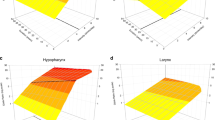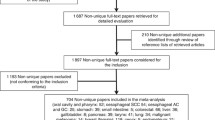Abstract
There have been few published studies on differences between Blacks and Whites in the estimated effects of alcohol and tobacco use on the incidence of head and neck cancer (HNC) in the United States. Previous studies have been limited by small numbers of Blacks. Using pooled data from 13 US case–control studies of oral, pharyngeal, and laryngeal cancers in the International Head and Neck Cancer Epidemiology Consortium, this study comprised a large number of Black HNC cases (n = 975). Logistic regression was used to estimate adjusted odds ratios (OR) and 95% confidence intervals (CI) for several tobacco and alcohol consumption characteristics. Blacks were found to have consistently stronger associations than Whites for the majority of tobacco consumption variables. For example, compared to never smokers, Blacks who smoked cigarettes for > 30 years had an OR 4.53 (95% CI 3.22–6.39), which was larger than that observed in Whites (OR 3.01, 95% CI 2.73–3.33; pinteraction < 0.0001). The ORs for alcohol use were also larger among Blacks compared to Whites. Exclusion of oropharyngeal cases attenuated the racial differences in tobacco use associations but not alcohol use associations. These findings suggest modest racial differences exist in the association of HNC risk with tobacco and alcohol consumption.
Similar content being viewed by others
References
Torre LA, Bray F, Siegel RL, Ferlay J, Lortet-Tieulent J, Jemal A (2015) Global cancer statistics. CA Cancer J Clin 65(2):87–108
Daraei P, Moore CE (2015) Racial disparity among the head and neck cancer population. J Cancer Educ 30:546–551
American Cancer Society (2016) Cancer facts figs. American Cancer Society, Atlanta
SEER*Stat 8.2.1, using rates from1973 to 2012 and age-adjusted to the 2000 Census population
Stingone JA, Funkhouser WK, Weissler MC, Bell ME, Olshan AF (2013) Racial differences in the relationship between tobacco, alcohol, and squamous cell carcinoma of the head and neck. Cancer Causes Control 24(4):649–664
Morris Brown L, Check DP, Devesa SS (2011) Oropharyngeal cancer incidence trends: diminishing racial disparities. Cancer Causes Control 22(5):753–763
Viens LJ, Henley SJ, Watson M, Markowitz LE, Thomas CC, Thompson TD, Razzaghi H, Saraiya M, Centers for Disease Control and Prevention (CDC) (2016) Human papillomavirus–associated cancers—United States, 2008–2012. MMWR 65(26):661–666
Hashibe M (2010) Risk factors: tobacco and alcohol. In: Olshan AF (ed) Epidemiology, pathogenesis, and prevention of head and neck cancer. Springer, New York, pp 65–85
Hashibe M, Brennan P, Benhamou S et al (2007) Alcohol drinking in never users of tobacco, cigarette smoking in never drinkers, and the risk of head and neck cancer: pooled analysis in the International Head and Neck Cancer Epidemiology Consortium. J Natl Cancer Inst 99(10):777–789
Day GL, Blot WJ, Austin DF et al (1993) Racial differences in risk of oral and pharyngeal cancer: alcohol, tobacco, and other determinants. J Natl Cancer Inst 85(6):465–473
Winn DM, Lee YC, Hashibe M et al (2015) The INHANCE consortium: toward a better understanding of the causes and mechanisms of head and neck cancer. Oral Dis 21(6):685–693
Wyss A, Hashibe M, Lee YA et al (2016) Smokeless tobacco use and the risk of head and neck cancer: pooled analysis of US studies in the INHANCE consortium. Am J Epidemiol. https://doi.org/10.1093/aje/kww075
Jayaprakash V, Rigual NR, Moysich KB et al (2006) Chemoprevention of head and neck cancer with aspirin. Arch Otolaryngol Head Neck Surg 132(11):1231–1236
D’Souza G, Gross ND, Pai SI et al (2014) Oral human papillomavirus (HPV) infection in HPV-positive patients with oropharyngeal cancer and their partners. J Clin Oncol 32(23):2408–2415
Wyss A, Hashibe M, Chuang SC et al (2013) Cigarette, cigar, and pipe smoking and the risk of head and neck cancers: pooled analysis in the International Head and Neck Cancer Epidemiology Consortium. Am J Epidemiol 178(5):679–690
Rothman KJ, Cann CI, Fried MP (1989) Carcinogenicity of dark liquor. Am J Public Health 79(11):1516–1520
Settle K, Posner MR, Schumaker LM et al (2009) Racial survival disparity in head and neck cancer results from low prevalence of human papillomavirus infection in black oropharyngeal cancer patients. Cancer Prev Res 2:776–781
Zevallos JP, Sandulache VC, Hamblin J et al (2016) Impact of race on oropharyngeal squamous cell carcinoma presentation and outcomes among veterans. Head Neck 38(1):44–50
Chaturvedi AK, Engels EA, Pfeiffer RM et al (2011) Human papillomavirus and rising oropharyngeal cancer incidence in the United States. J Clin Oncol 29(32):4294–4301
Wagenknecht LE, Cutter GR, Haley NJ et al (1990) Racial differences in serum cotinine levels among smokers in the coronary artery risk development in (young) adults study. Am J Public Health 80:1053–1056
Hebert JR, Kabat GC (1988) Menthol cigarettes and esophageal cancer. Am J Public Health 78:986–987
Sidney S, Tekawa MS, Friedman GD (1989) Mentholated cigarette use among multiphasic examinees, 1979–1986. Am J Public Health 79(10):1415–1416
Orleans CT, Strecher VJ, Schoenbach VJ et al (1989) Smoking cessation initiatives for black Americans: recommendations for research and intervention. Health Educ Res 4(1):13–25
Ahijevych K, Parsley LA (1999) Smoke constituent exposure and stage of change in black and white women cigarette smokers. Addict Behav 24(1):115–120
Wagenknecht LE, Haley NJ, Jacobs DR (1992) Wagenknecht and colleagues respond. Am J Public Health 82:1173
Caraballo RS, Holiday DB, Stellman SD et al (2011 Jul) Comparison of serum cotinine concentration within and across smokers of menthol and nonmenthol cigarette brands among non-Hispanic black and non-Hispanic white U.S. adult smokers, 2001–2006. Cancer Epidemiol Biomark Prev 20(7):1329–1340
Hoffman AC (2011) The health effects of menthol cigarettes as compared to non menthol cigarettes. Tob Induc Dis 9(Suppl 1):S7
Lee PN (2011) Systematic review of the epidemiological evidence comparing lung cancer risk in smokers of mentholated and nonmentholated cigarettes. BMC Pulm Med 11:18
Kabat GC, Hebert JR (1994) Use of mentholated cigarettes and oropharyngeal cancer. Epidemiology 5(2):183–188
Blot WJ, Cohen SS, Alrich M, McLaughlin JK, Hargreaves MK, Signorello LB (2011) Lung cancer risk among smokers of menthol cigarettes. J Natl Cancer Inst 103(10):810–816
Zu AZ, Renner CC, Hatsukami DK et al (2013) The ability of plasma cotinine to predict nicotine and carcinogen exposure is altered by differences in the CYP2A6: the influence of genetics, race, and sex. Cancer Epidemiol Biomark Prev 22(4):708–718
Ross KC, Gubner NR, Tyndale RF et al (2016) Racial differences in the relationship between rate of nicotine metabolism and nicotine intake from cigarette smoking. Pharmacol Biochem Behav 148:1–7
Ho MK, Faseru B, Choi WS et al (2009) Utility and relationships of biomarkers of smoking in African-American light smokers. Cancer Epidemiol Biomark Prev 18:3426–3434
Muscat JE, Pittman B, Kleinman W, Lazarus P, Stellman SD, Richie JP Jr (2008) Comparison of CYP1A2 and NAT2 phenotypes between black and white smokers. Biochem Pharmacol 76(7):929–937
Varela-Lema L, Taioli E, Ruano-Ravina A et al (2008) Meta-analysis and pooled analysis of GSTM1 and CYP1A1 polymorphisms and oral and pharyngeal cancers: a HuGE-GSEC review. Genet Med 10(6):369–384
Zhang X, Su T, Zhang QY et al (2002) Genetic polymorphisms of human CYP2A13 gene: identification of single-nucleotide polymorphisms and functional characterization of an Arg257Cys variant. J Pharmacol Exp Ther 302(2):416–423
Patel YM, Stram DO, Wilkens LR et al (2015) The contribution of common genetic variation to nicotine and cotinine glucuronidation in multiple ethnic/racial populations. Cancer Epidemiol Biomark Prev 24(1):119–127
Wassenaar CA, Conti DV, Das S et al (2015) UGT1A and UGT2B genetic variation alters nicotine and nitrosamine glucuronidation in European and African American smokers. Cancer Epidemiol Biomark Prev 24(1):94–104
Elahi A, Bendaly J, Zheng Z et al (2003) Detection of UGT1A10 polymorphisms and their association with orolaryngeal carcinoma risk. Cancer 98(4):872–880
Benowitz NL, Dains KM, Dempsey D, Wilson M, Jacob P (2011) Racial differences in the relationship between number of cigarettes smoked and nicotine and carcinogen exposure. Nicotine Tob Res 13(9):772–783
Perez-Stable EJ, Herrera B, Jacob P, Benowitz NL (1998) Nicotine metabolism and intake in black and white smokers. JAMA 280(2):152–156
Berg JZ, Mason J, Boettcher AJ, Hatsukami DK, Murphy SE (2010) Nicotine metabolism in African Americans and European Americans: variation in the glucuronidation by ethnicity and UGT2B10 haplotype. J Pharmacol Exp Ther 332(1):202–209
Wayne M, Lango M, Sewell D, Zahurak M, Sidransky D (1999) Head and neck cancer in nonsmokers: a distinct clinical and molecular entity. Laryngoscope 109(10):1544–1551
Farshadpour F, Hordijk GJ, Koole R, Slootweg PJ (2007) Non-smoking and non drinking patients with head and neck squamous cell carcinoma: a distinct population. Oral Dis 13(2):239–243
Dahlstrom KR, Little JA, Zafereo ME, Zafereo ME, Lung M, Wei Q, Sturgis EM (2008) Squamous cell carcinoma of the head and neck in never smoker-never drinkers: a descriptive epidemiologic study. Head Neck 30(1):75–84
Yeager DS, Krosnick JA (2010) The validity of self-reported nicotine product use in the 2001–2008 National Health and Nutrition Examination Survey. Med Care 48(12):1128–1132
Brigham J, Lessov-Schlaggar CN, Javitz HS, McElroy M, Krasnow R, Swan GE (2008) Reliability of adult retrospective recall of lifetime tobacco use. Nicotine Tob Res 10(2):287–299
Friesema IHM, Veenstra MY, Zwietering PJ, Knottnerus JA, Garretsen HF, Lemmens PH (2004) Measurement of lifetime alcohol intake: utility of a self-administered questionnaire. Am J Epidemiol 159(8):809–817
Goren A, Annunziata K, Schnoll RA, Suaya JA (2014) Smoking cessation and attempted cessation among adults in the United States. PLoS ONE 9(3):e93014
Department of Health and Human Services (1998) Tobacco use among U.S. Racial/Ethnic Minority Groups—Blacks, American Indians and Alaska Natives, Asian Americans and Pacific Islanders, and Hispanics: a report of the Surgeon General: USDHHS, Centers for Disease Control and Prevention, National Center for Chronic Disease Prevention and Promotion, Office of Smoking and Health. Government Printing Office, Washington, DC
Fu SS, Kodl MM, Joseph AM et al (2008) Racial/ethnic disparities in the use of nicotine replacement therapy and quit ratios in lifetime smokers ages 25 to 44 years. Cancer Epidemiol Biomark Prev 17(7):1640–1647
Acknowledgments
The INHANCE Consortium core data pooling was supported by NIH Grants (NCI R03CA113157 and NIDCR R03DE016611). The individual studies were supported by the following Grants: New York Multicenter study, NIH P01CA068384 K07CA104231; Seattle study (1985–1995), NIH R01CA048996 and R01DE012609; Iowa study, NIDCR R01DE011979, NIDCR R01DE013110, NIH FIRCA TW001500 and Veterans Affairs Merit Review Funds; North Carolina study (1994–1997), NIH R01CA061188, and in part by a Grant from the National Institute of Environmental Health Sciences P30ES010126; Tampa study: NIH P01CA068384, K07CA104231, and R01DE013158; Los Angeles study: NIH P50CA090388, R01DA011386, R03CA077954, T32CA009142, U01CA096134, and R21ES011667 and the Alper Research Program for Environmental Genomics of the UCLA Jonsson Comprehensive Cancer Center; Houston study: NIH R01ES011740 and R01CA100264; Boston study: NIH R01CA078609 and R01CA100679; US Multicenter study, The Intramural Program of the NCI, NIH, United States; MSKCC study, NIH R01CA051845; Seattle-LEO study, NIH R01CA030022; North Carolina (2002–2006), NCI R01CA90731-01 and NIEHS P30ES010126; Baltimore study, NIH DE016631.
Author information
Authors and Affiliations
Corresponding author
Electronic supplementary material
Below is the link to the electronic supplementary material.
Rights and permissions
About this article
Cite this article
Voltzke, K.J., Lee, YC.A., Zhang, ZF. et al. Racial differences in the relationship between tobacco, alcohol, and the risk of head and neck cancer: pooled analysis of US studies in the INHANCE Consortium. Cancer Causes Control 29, 619–630 (2018). https://doi.org/10.1007/s10552-018-1026-z
Received:
Accepted:
Published:
Issue Date:
DOI: https://doi.org/10.1007/s10552-018-1026-z




